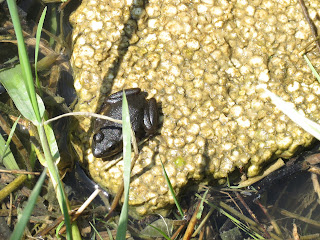 |
| The Virginia Bluebell (Mertensia virginica; also Virginia Cowslip, Lungwort Oysterleaf, Roanoke Bells) is a spring ephemeral plant with bell-shaped sky-blue flowers opening from pink buds, native to moist woodland in eastern North America. |
A report by Kee Dewdney on the day's activities:
Newport Forest
Weather: Prec. 4 mm; RH 87%; BP 101.4 kPa; ovcst; N 5-15 kmh, T 6º C
Purpose: TTLT Work Day
Participants: Pat, Kee, Jane Bowles (plus volunteers listed below)
It was, as my father used to say about unnaturally cold days, “good working
weather”. By 1:30 pm some 17 volunteers had shown up in the Lower Meadow,
ready to fix road and trail, cut thorn trees, and pull Garlic Mustard. Pat kept tabs
on personnel & materiel from the trailer headquarters, coordinated the food
supply, and gathered bird reports. Jane Bowles had arrived an hour earlier to
check the boundary line that runs through the Fleming Creek Forest.
The road crew headed to the Upper Meadow, where they leveled the Mudhole,
then spread gravel over the surface. It was thought that a drain beneath the
mudhole would help to fix the problem of getting through it during wet seasons,
but the idea was nixed by a TTLT Property Management Committee wishing to
be strict about not adding non-natural materials to the site. With the graveling
done, Jane had the road crew cutting thorn trees. This is part of the ongoing effort
to preserve habitat for Bobolinks & Meadowlarks.
More can be said about the trail crew because this writer accompanied them.
Thanks to a bit of recent rain, several wet spots along the River Bluffs portion of
the trail had become soggy. A wonderfully labor-intensive operation was to create
a corduroy of inch-thick sticks. Volunteers scrambled through underbrush in
search of dead branches to break into trail-wide lengths. Even as Terry Keep, ably
assisted by his very young son, Alexander, rebuilt the safety steps on an especially
steep portion of the bluffs leg of the trail. Working ahead of us, Ron Casier kept
his chainsaw busy on deadfalls and trees leaning over the trail.
The volunteers moved into the Riverside Forest, marveling at the Bluebells, even
as they searched out slender logs in the adjacent forest to line the trail. At one
point a Wild Turkey flew through the forest, just below the canopy. All heads
turned up. The sight could hardly have been more dramatic if an airliner had
flown through the woods. While all this was going on, Darren Jacobs and his
friend Richard Hopkins were pulling Garlic Mustard wherever they could find it.
Back at the Nook, the Work Day volunteers straggled in by twos and threes until
the snack-and-drink table became crowded with hungry hands. At one point Pat
was asking who saw the Bald Eagle when the bird itself flew over.
Saturday April 21 2012
12:45 - 6:00 pm
As she was about to leave, Jane remarked that she had never seen the Bluebells in
bloom. I volunteered to take her. Jane was already behind schedule. “We’ll have
to run!” Like an idiot I agreed. She ran ahead, but this former track and field guy
didn’t even try to keep up, waiting for her to tire, instead. Puff puff pant pant.
Three heart attacks and one stroke later, I caught up with her on the bluffs, where
she was inspecting the trailwork. Finally we arrived at Bluebell Woods. Jane took
several pictures for the record and we then double-timed back to camp.
After everyone had gone, Pat and I cleaned up. We both seemed to have the same
aches & pains, but nothing a shower of hot liniment wouldn’t take care of.
Volunteers: (18)
Muriel Andreae (T), Peter Andreae (R), Jane Bowles (Coordinator), Erin Carroll
(T), Ron Casier (T), Terry Grawey (T), Richard Hopkins (G), Darren Jacobs (G),
Alexander Keep (T), Terry Keep (T), Ron Martin (R), Carolyn McDonald (R),
Linda McDougall (T), Bruce Parker (T), Joel Parker (T), Gordon Price (T), Jim
Rule (T), Jennifer Slauenwhite (T), Diane VonBommel (R)
Note: ‘T’ denotes trail worker, ‘R’ denotes road worker (& thorn-cutting), ‘G’
denotes Garlic Mustard puller.
Birds: (19)
American Crow (EW); American Robin (LM); Bald Eagle (TR); Black-capped
Chickadee (GF); Blue Jay (Tr); Brown-headed Cowbird (Tr); Canada Goose
(TR); Downy Woodpecker (Tr); Eastern Towhee (BCF); Field Sparrow (UM);
Mourning Dove (GF); Northern Cardinal (Tr); Northern Flicker (UM/ER); Red-
bellied Woodpecker (RSF); Song Sparrow (LM); Turkey Vulture (LM); White-
breasted Nuthatch (Tr); Wild Turkey (RSF); Wood Duck (FCF)



























































